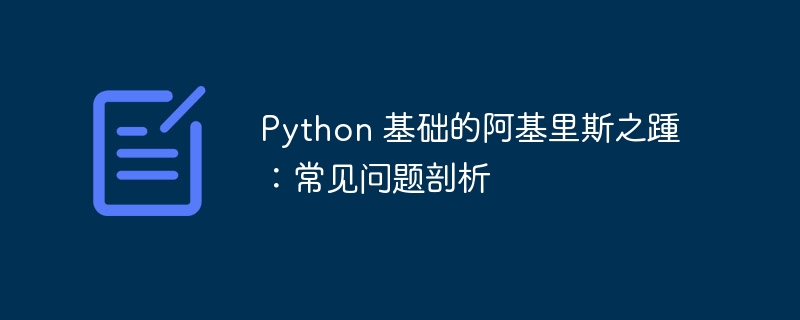Home >Backend Development >Python Tutorial >The Achilles Heel of Python Basics: An Analysis of Common Problems
The Achilles Heel of Python Basics: An Analysis of Common Problems
- 王林forward
- 2024-03-16 19:30:121135browse

1. Performance bottleneck
- python is an interpreted language, which means that the code is interpreted line by line at runtime rather than compiled into machine code ahead of time. This interpretation process is slower than the compilation process, resulting in Python code having limited performance when handling intensive tasks.
- Dynamic typing is used extensively in Python, which adds runtime checking and type casting overhead.
- The lack of low-level memory management in Python makes it difficult to optimize memory usage and avoid memory leaks.
2. Limited concurrency
- Python's traditional GIL (Global Interpreter Lock) limits parallel processing. The GIL ensures that only one thread can execute Python code at a time, thus limiting multi-core CPU utilization. The lack of native
- concurrency and parallelism libraries in Python leads to challenges in developing parallel applications.
3. Memory management
- The lack of low-level control over memory in Python makes it difficult to optimize memory usage.
- Python's garbage collector can suffer from fragmentation and latency issues, sometimes leading to performance bottlenecks.
- The reference counting mechanism in Python is prone to circular references, leading to memory leaks.
4. Type system
- Python's dynamic type system provides flexibility, but can also lead to type errors and runtime exceptions.
- Python lacks strong type checking and casting, which makes debugging and maintaining code difficult.
- Python's type system is not suitable for large or complex applications, where type errors can have catastrophic consequences.
5. Limited library ecosystem
- Although Python has a large standard library, library support in some specific areas may be limited.
- Some popular libraries lack proper documentation or maintenance, which leads to difficulties in use and debugging.
- Python’s library ecosystem can sometimes be fragmented, with different libraries providing similar functionality, which can make choosing the right library difficult.
6. Security Vulnerabilities
- Python code is interpreted at runtime, which allows attackers to easily exploit
- security vulnerabilities using malicious code. The lack of strict input validation in Python makes applications vulnerable to injection attacks and other security attacks.
- The lack of native encryption and authentication mechanisms in Python increases the complexity of protecting sensitive data.
Mitigation Strategies
While these flaws constitute the "Achilles' heel" of Python's foundation, their impact can be mitigated through the following mitigation strategies:
- For performance bottlenecks, use a compiler (such as Cython or Numba) to convert Python code into faster machine code.
- Use coroutines or asynchronous
- programming to improve high concurrency . Manage memory carefully and use third-party libraries such as Memory Profiler to detect and resolve memory leaks.
- Write unit
- tests and use a static type checker (such as Mypy) to improve code reliability. Explore alternative libraries and look for well-maintained and well-documented libraries.
- Implement good security practices including input validation, encryption, and authentication.
The above is the detailed content of The Achilles Heel of Python Basics: An Analysis of Common Problems. For more information, please follow other related articles on the PHP Chinese website!
Statement:
This article is reproduced at:lsjlt.com. If there is any infringement, please contact admin@php.cn delete
Previous article:Uncover the magic curtain of Python control flowNext article:Uncover the magic curtain of Python control flow

